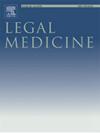The utility of drowning site inference through metagenomic diatom analysis
IF 1.3
4区 医学
Q3 MEDICINE, LEGAL
引用次数: 0
Abstract
The diatom test is one of the methods used to diagnose drowning in forensic autopsies. Metagenomic diatom analysis may reveal where a drowning occurred. We evaluated whether metagenomic diatom analysis could be used to infer waters, watersheds, and geographic locations using 166 water samples from 64 locations (freshwater: 55; seawater: 9). Principal component analysis (PCA) in all samples revealed no specific clusters for waters or watersheds. In one river, the three samples at the same site generally tended to be in close clusters, but there were some cases where the three sites were far from each other. The precise geographic location could thus not be reliably identified. However, PCA of data from dams, lakes, and retention basins revealed sites with independent clusters, suggesting unique diatom compositions. Diatoms of seawater were not detected in freshwater. The high number of Actinoptychus, Chaetoceros, and Skeletonema detected in seawater samples suggested that they are useful for seawater identification. This method required only 2 mL of water; it suggests that this method can be applied to actual samples. In summary, it was difficult to infer the geographic location and waters or watersheds, but the freshwater/seawater distinction could be easily made, and depending on the application, it may be useful in forensic science practice.
通过元基因组硅藻分析推断溺水地点的实用性。
硅藻测试是法医验尸中诊断溺水的方法之一。元基因组硅藻分析可以揭示溺水发生的地点。我们利用来自 64 个地点(淡水:55 个;海水:9 个)的 166 个水样,评估了元基因组硅藻分析是否可用于推断水域、流域和地理位置。对所有样本进行的主成分分析(PCA)显示,水域或流域没有特定的群集。在一条河流中,同一地点的三个样本一般倾向于处于相近的群组中,但也有三个地点相距较远的情况。因此,无法可靠地确定准确的地理位置。不过,对来自水坝、湖泊和蓄水池的数据进行 PCA 分析后发现,这些地点具有独立的聚类,表明硅藻组成具有独特性。淡水中未检测到海水硅藻。在海水样本中检测到大量的 Actinoptychus、Chaetoceros 和 Skeletonema,这表明它们可用于海水鉴定。该方法仅需 2 毫升水,这表明该方法可用于实际样本。总之,很难推断地理位置和水域或流域,但很容易区分淡水和海水,根据应用情况,它可能在法医学实践中有用。
本文章由计算机程序翻译,如有差异,请以英文原文为准。
求助全文
约1分钟内获得全文
求助全文
来源期刊

Legal Medicine
Nursing-Issues, Ethics and Legal Aspects
CiteScore
2.80
自引率
6.70%
发文量
119
审稿时长
7.9 weeks
期刊介绍:
Legal Medicine provides an international forum for the publication of original articles, reviews and correspondence on subjects that cover practical and theoretical areas of interest relating to the wide range of legal medicine.
Subjects covered include forensic pathology, toxicology, odontology, anthropology, criminalistics, immunochemistry, hemogenetics and forensic aspects of biological science with emphasis on DNA analysis and molecular biology. Submissions dealing with medicolegal problems such as malpractice, insurance, child abuse or ethics in medical practice are also acceptable.
 求助内容:
求助内容: 应助结果提醒方式:
应助结果提醒方式:


